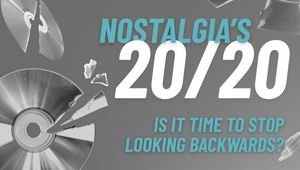
Celebrating 50 Years of Nike with an AR Archive Experience

To celebrate Nike’s 50th anniversary, LA-based creative company BUCK brought half a century of iconic athletic artefacts into an accessible, augmented reality experience for people in Nike stores worldwide. Capturing the spirit of DNA (the Department of Nike Archives), the in-store experience uses significant artefacts from 11 Nike product stories to engage consumers with Nike’s legacy.
Customers could use their phones’ QR scanners to unlock culturally significant artefacts in Nike stores around the world, revealing a virtual box and collection of important Nike inventions that were made viewable and immersive using WebAR and Simultaneous Localisation and Mapping (SLAM) technology. These artefacts ranged from the prototypes and original designs for Nike’s Track Spike, Waffle Iron and Pegasus shoes to the original ‘Swoosh’ design by Carolyn Davidson.
Partnering with AR specialists Zappar, BUCK took 17 3D-scanned assets from Nike’s archives, mapped a further six artefacts from 2D to 3D, and optimised them for a real-time AR experience on mobile devices. Visitors could then explore the artefacts through touch gestures and the app’s UI in what BUCK believes is “the future of storytelling within the retail space.”
To discuss how this campaign came about and the technical skills required to create an immersive in-store AR experience, LBB’s Ben Conway spoke with BUCK’s art director, Helena Dong, executive producer - experience, Daniell Phillips, and group creative director, Evan Boehm.
LBB> Where did the initial creative spark for this campaign come from? What was the brief like for Nike’s 50th anniversary?
Evan> Our brief from Nike’s Global Brand Experience team was to bring the brand’s past, present and future to life in stores globally. They also wanted the idea to capture the spirit of DNA (Department of Nike Archives) and to support the future of storytelling within a retail environment. The AR experience we created is a portal into the DNA archives for visitors to Nike stores, opening up the archives to a global audience for the very first time. Through the virtual display of eleven culturally-significant artefacts, the experience encourages consumers to engage with Nike’s legacy.
Daniell> Nike had a number of stories that they were keen to tell, all of which were related to the brand’s legacy and built around specific archive artefacts. The 50th anniversary was an opportunity to surface these brand moments through interaction with the iconic objects central to these stories.
LBB> Where did the inspiration or idea for using AR come from? Have you worked on similar projects before?
Helena> BUCK has a long history of innovation in AR. Some similar projects include making selfies cool with the face filters you know and love on Instagram, a game that teaches kids about financial literacy for Ally Bank, and art museum The Broad’s first foray into AR for Takashi Murakami’s solo show in Los Angeles. We loved the opportunity with this brief to embrace the possibilities of WebAR as a globally accessible entry point to on-site AR.

LBB> How did you go about making this AR experience more interactive and engaging for customers - beyond just reading information on their phones?
Helena> The AR experience encourages people to engage with Nike’s legacy in a new way. Using their smartphone’s QR scanner, shoppers can unlock artefacts using any modern smartphone. Each of the 11 stories comprising the experience is self-contained within a single, virtual box that opens up to reveal an array of artefacts. Visitors can explore the artefacts through touch gestures and the app’s UI. Accented with orange rims, each box was designed to mimic frosted glass - shrouding the artefact in mystery and enticing users to engage with each story to discover layers of information about each object.
The experience was available as an activation to Nike stores worldwide, and was particularly central to Nike’s flagship ‘House of Innovation’ stores in Paris, Shanghai and New York City. Reaction in these cities has been extremely positive, with the campaign extending beyond its original timeline to allow audiences to continue to explore the archives in store. The experience was installed within bespoke displays in Nike stores globally and was localised to 11 languages to enable Nike fans the world over to enjoy the experience.
LBB> What is WebAR and ‘Simultaneous Localisation and Mapping’ (SLAM) technology - and what do they add to the experience?
Helena> We chose WebAR because it allows for an AR experience that doesn’t require users to download any apps - meaning they can access the experience instantly. This is important because modern smartphones already have web browsers installed, creating a low-friction entry point to AR experiences. Simultaneous Localization and Mapping, or SLAM, is really cool because it allows objects to be spatially anchored in front of the user. This means you can walk around each artefact as though it were truly present in your world, and it brings a crucial sense of awe and immersion to the experience.
LBB> Did you work with a company to assist with the tech development side of the experience? Who helped optimise the AR models and interactive elements from Nikes’ archives?
Helena> BUCK did the tech development all in-house for this project! We took 3D-scanned assets of 17 items from Nike’s archives and optimised them to make them compatible for a real-time AR experience on a mobile device.
Daniell> We partnered with AR specialists Zappar and their Zapworks toolkit to power the WebAR for a frictionless and fast entry into the experience.
List of 17 items 3D scanned:
- Prototype Spike Made by Bill Bowerman
- Steve Prefontaine Prototype Spike Handmade by Bill Bowerman
- Track Spike Handmade by Bill Bowerman and Worn by Steve Prefontaine
- The Original Waffle Iron
- Vintage Waffle Iron
- Moon Shoe Handmade by Bill Bowerman and Worn by Pat Tyson
- Pegasus (M)
- Air Pegasus ‘89
- Air Pegasus 2000
- Air Swoopes Autographed by Sheryl Swoopes
- Special Make-up Shoe Worn by Joan Benoit
- Layered Air Experiments by Frank Rudy
- Prototype of Air Max
- Gas Test Bag Modified by Frank Rudy
- Mercurial Inspiration Prototype Shoe
- Nike Mercurial SG
- Mercurial Colorway Prototype
List of 6 items 2D mapped into 3D - not 3D scanned:
- Waffle Trainer in ‘Hot Waffles to Go’
- Original Windrunner Sketch by Diane Katz
- Nike Sports Research Lab Brochure
- LA Campaign City Building Featuring Joan Benoit Samuelson
- Original Swoosh Design by Carolyn Davidson
- First Blue Ribbon Sports Retail Storefront at 3107 Pico Blvd. in Santa Monica, California

LBB> Let’s get a little bit nerdy - how exactly do you ‘optimise’ and prepare 3D models for this kind of experience? And what is the workflow like of building an AR experience?
Daniell> We love getting nerdy! Working in AR requires us to work with much lower poly counts for 3D models and to find creative ways to ensure high-fidelity visuals, regardless of the platform. Our artists are highly skilled in adapting to the parameters of the medium and love finding ways to make models and assets look spectacular in AR.
The biggest challenge of this project was definitely in the reproduction of the 3D assets themselves - ensuring that the Nike team were happy with how their prized artefacts were rendered as virtual objects. 3D scanning has matured a great deal, and our scan partners, Digital Scan 3D, provided us with great base-level models to work from, but we required all of our skill in model optimisation and texturing to push the fidelity of these items as high as possible, while still allowing for fast-loading and integration - whatever the network connection. Working with these precious archival objects and painstakingly recreating them virtually was a nerve-wracking and exacting endeavour!
LBB> Where do you see the future of this tech and style of experience going? What learnings will you bring forward onto future projects?
Daniell> AR will continue to evolve and become a mainstay of how we engage with the physical world as a layer that enhances how we experience our everyday lives. As a medium that inherently encourages interaction and the exploration of 3D objects and worlds, there is a natural extension into areas such as retail and cultural institutions.
We’re increasingly seeing museums and galleries, for example, exploring ways in which AR can provide a new way of accessing and engaging with their collections. Retail spaces are using AR to enhance consumer experiences and expand what is possible in a physical store layout. We love how AR provides a seamless entry point to virtual worlds and explorations through simplicity and intuitive interactions, and we love that our artists and creative teams get to push the boundaries of these new mediums forward with craft and care.















